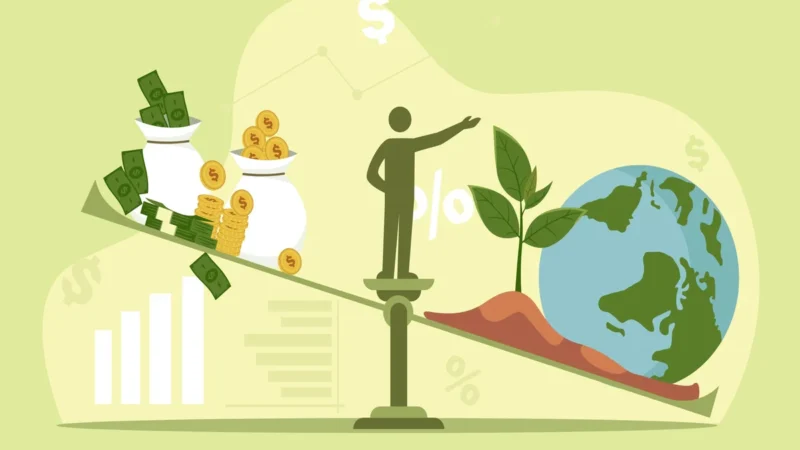What is Circular Economy: Importance and Benefits

The concept of a circular economy has gained significant attention in recent years as a sustainable alternative to the traditional linear economy. It aims to decouple economic growth from resource depletion and environmental degradation. This article provides an in-depth exploration of the circular economy, its principles, benefits, challenges, and potential impact on sustainable development.
I. Understanding the Circular Economy
The circular economy is an economic system designed to minimize waste and maximize the efficiency of resource use. It represents a shift away from the traditional linear model of production, consumption, and disposal. Instead, it promotes a closed-loop system in which materials, products, and resources are kept in circulation for as long as possible through strategies such as recycling, reusing, remanufacturing, and refurbishing.
II. Key Principles of the Circular Economy
The circular economy is built on several core principles, including:
- Design for durability and recyclability: Products should be designed to last longer and be easily disassembled for recycling or reuse.
- Resource optimization: Maximizing the value and lifespan of materials through efficient use and regeneration.
- Waste prevention and management: Minimizing waste generation and finding innovative ways to manage and repurpose waste.
- Product lifecycle extension: Encouraging product repair, refurbishment, and the development of secondary markets for used goods.
III. Benefits of the Circular Economy
The circular economy offers numerous benefits across economic, environmental, and social dimensions. These include:
- Reduced resource consumption: By promoting resource efficiency and recycling, the circular economy helps conserve natural resources and reduces the pressure on ecosystems.
- Economic growth and job creation: Transitioning to a circular economy can stimulate economic growth by fostering innovation, creating new business opportunities, and generating jobs in sectors such as recycling, renewable energy, and eco-design.
- Enhanced resilience and risk mitigation: By diversifying supply chains, promoting local production, and reducing dependence on finite resources, the circular economy strengthens resilience to economic and environmental shocks.
IV. Challenges and Transitioning to a Circular Economy
Despite its potential, the circular economy faces various challenges, including:
- Shifting mindsets and business models: Transitioning from a linear to a circular economy requires changes in mindset, business practices, and consumer behavior.
- Infrastructure and technology gaps: Developing the necessary infrastructure and technologies to support circular systems can be a significant barrier.
- Policy and regulatory frameworks: Governments play a crucial role in creating enabling environments through supportive policies, regulations, and incentives.
V. Circular Economy and Sustainable Development
The circular economy aligns closely with the principles of sustainable development, providing a holistic approach to environmental, social, and economic challenges. By reducing waste, conserving resources, and promoting inclusivity, the circular economy contributes to achieving the United Nations Sustainable Development Goals (SDGs).
Key Takeaways:
The circular economy represents a promising pathway towards a more sustainable future. By reimagining how we produce, consume, and manage resources, it offers a compelling framework for addressing environmental challenges, fostering economic growth, and promoting social well-being.
FAQs about the circular economy
What is a circular economy?
A circular economy is an economic system that aims to minimize waste and maximize the efficient use of resources. It promotes the idea of keeping materials, products, and resources in circulation for as long as possible through strategies like recycling, reusing, and refurbishing.
How does the circular economy differ from the traditional linear economy?
In a linear economy, resources are extracted, processed into products, used, and then discarded as waste. In contrast, a circular economy seeks to close the loop by ensuring that products and materials are reused, recycled, or repurposed, thus minimizing waste and preserving resources.
What are the benefits of a circular economy?
The circular economy offers several benefits, including reduced resource consumption, economic growth, job creation, enhanced resilience to shocks, and a decreased environmental footprint. It also supports the transition to a more sustainable and equitable society.
How can I contribute to the circular economy?
You can contribute to the circular economy in various ways. Start by reducing waste through practices such as recycling, reusing items, and repairing products instead of replacing them. Support businesses that prioritize sustainability and circular practices. Choose products with minimal packaging and opt for durable and long-lasting goods.
What are the challenges of implementing a circular economy?
Implementing a circular economy requires a shift in mindset, business models, and consumer behavior. It also requires investments in infrastructure and technologies that support circular systems. Additionally, supportive policies and regulations are crucial for creating an enabling environment for the circular economy.
Can the circular economy help address climate change?
Yes, the circular economy can contribute to climate change mitigation. By reducing waste and promoting resource efficiency, it minimizes greenhouse gas emissions associated with resource extraction, manufacturing, and waste disposal. It also encourages the use of renewable energy sources and supports the development of sustainable practices.
Is the circular economy applicable to all industries?
Yes, the circular economy can be applied to various industries, including manufacturing, agriculture, construction, and consumer goods. Each sector can adopt circular practices tailored to its specific needs and challenges. The transition to a circular economy requires collaboration and innovation across industries.


